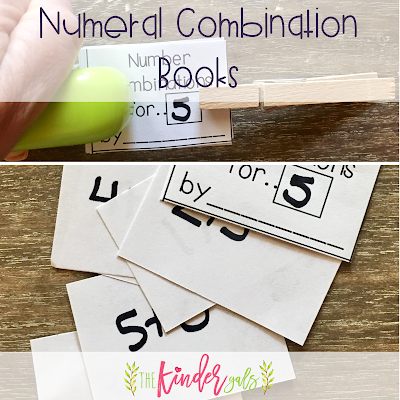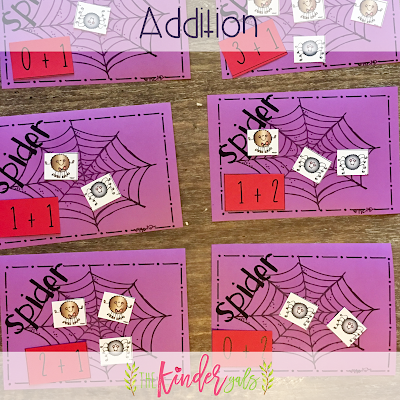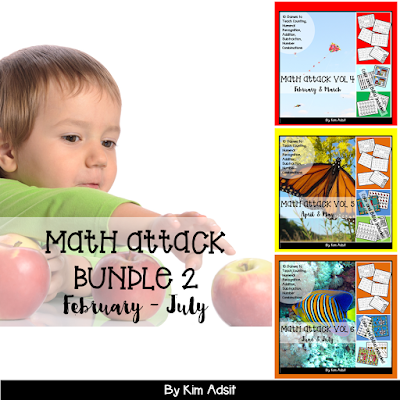First, let's look at how children develop number sense:
Say the Number Word
The first thing children learn to do is to "Say the Number Word." When I first started teaching we called this "rote-counting". In this stage children have memorized a sequence of words. They do not have a mental image of how many each numeral represents. Children at this stage will benefit from singing songs and saying rhymes that repeat the sequence of numerals.
One to One Correspondence
The next stage in number development is counting with one to one correspondence. In this stage, children are learning to touch each object and to assign a number word to that object. They may, or may not, recognize any numerals at this point. In this example, the child counts the dots on the card. Then, he puts that many pumpkins on the fence.
When doing the math mats, I give each child 6-8 game boards and enough counting pieces to complete the activity. (I usually make the games with about 100 counting pieces.) The child repeats the one to one counting for each of the game boards. When I made these games, I tried to think about COLOR ink! I made the games both in color and black and white. That way I can pick and choose how I use color ink when printing. Instead of printing the colored pumpkins, I could print these black and white pumpkins on orange paper.
Or, I could print just the game boards and use these pumpkin erasers from the Target Dollar Spot as the counting pieces.
Cardinality
The next stage in number development is cardinality. This is a word that few teachers have an understanding for. Cardinality means that the child knows that the last number says refers to the total number of objects in the set. The child begins just like above, with one to one correspondence. AFTER the child has counting out the pieces, you ask, "How many pumpkins?". If the child gives you the correct answer, they have developed cardinality. If they give you an incorrect number, or if they count again, they do not have cardinality.
Conservation
After children have developed cardinality, the next stage is conservation of number. This means that the child understands that simply by moving the objects around on the board, they do not have more or less. THIS is super important when the children begin addition--more on that later.
Subitizing
After children have developed conservation, the next stage is subitizing. Subitizing is the child's ability to look at a set of objects and tell you how many there are without having to count them. In the pumpkin game, if the child looks at the set of dots and says how many there are without counting, they can subitize for that number. A child's ability to subitize is developed by children seeing and counting multiple configurations of a number (or a set of objects) many times. Here's what's cool--ALL of the children can be playing this same game. To the casual observer is looks like they are all in the same place in number sense--but that isn't necessarily true! They could be working in any of these stages all while playing with the exact same mat mats and with the exact same dot cards!
Numeral Recognition
Number sense refers to the quantity of objects. When we say "number" we are referring to that set of objects. When we say "numeral" we are referring to a symbol that represents that number! To introduce numerals, we simply remove the dot cards and replace them with numeral cards. The child places one numeral on each game board and counts a set of objects to match the numeral.
Here's another option for saving ink. Instead of printing the colored apples, I can choose the black and white apples and print them on red paper.
How fun are these paper plates I picked up at Target with the Sweet Tart candies for counting pieces? This is another type of math math! I could use this with the dot cards, too!
Numeral Writing
Once children have developed fluency with one to one counting with numeral recognition, they can begin to work on writing the numerals. To do this, simply provide a small container with small slips of white paper. The children lay a slip by each numeral. Then, they write the numerals on the slips.
The children collect their strips of paper and stack them. Using a clothespin, clip all of the strips together. At the opposite end, staple with the stapler. This is a great way for kids to be able to use the stapler without fear of stapling their fingers!
Once the children have mastered the numerals 0-10, move on to the numerals 11-20 simply by adding more counting pieces. Here is another Target find! These cute pumpkin plates are paired with pumpkin seeds for counting!
Number Combinations
These same games can be used to teach number combinations. Simply remove the numeral cards and add in several cards, all with the same numeral. For example, if the child is working on combinations for 5, then you will put enough "5" cards for them to use on all of the math mats.
***Important thing to think about:
Once the children get to this step, you will want them to have the opportunity to divide their counting pieces into two groups. In this example, there are leaves and acorns. They can put 1 leaf and 4 acorns to make 5. But, if I only had leaves, they could put 1 leaf on the ground and 4 leaves in the basket. This means that you want ALL of your games to have the ability to do this! That way, regardless as to where the children are working, they can all use the same math mats. (More on this part later.)
Once the children have developed fluency with number combinations for 5, you can take this to the abstract level by having the children record their combinations on a slip of paper. The important thing to remember is that the learning, the solving of the problem, ALL occurred at the conceptual level (with the child manipulating counters). Only then, do we want to bridge to the abstract!
Now the kids can take their number combination equations and staple them together to make their booklet.
Addition
Sticking with the same games, we can also teach addition. Here the kids are putting brown and black spiders onto the spider web to match the equations. Here we are starting with the abstract, but allowing children to solve these equations conceptually by manipulating the counting pieces. Before beginning this step, you will want to call kids into a small group that are ready for addition. Give each child one game board. As you tell story problems, invite the children to manipulate the pieces to solve the equation. Once they understand this concept (it could take 4-5 small group times), introduce the equations. Tell a story problem that matches the equation. After you have modeled several times, invite the children to tell story problems. Once this is mastered, give each child their own math mats with a variety of equations. Invite them to spread out the mats and solve each equation. Once they have finished, the children select one of the cards to tell you an addition story.
Notice how I printed my webs on purple paper? The game boards are available in the color version as well, but I think the blank and white version on purple paper works great and saves money!
If the children are able to create text, you may decide to have them record a story problem to match one of their equations.
Subtraction
Finally these same boards can be used to teach subtraction. Repeat the same steps as addition just this time use subtraction!
I made these math mats to go with some bat clip art! But, I found these cute cat erasers in the Target Dollar spot. They make perfect counters. (Hint: I always buy 2 packets of the counters.)
And here is a subtraction story.
Set Up
I use math mats as one on my math centers. Every few weeks I change out the games to keep them fresh. You will want to have more games than kids that will be working in that center. If I have 5 kids in this center, I want to have 8-9 games. This ensures there will always be a choice!
Once the children select the game, they find their math pocket. I keep these in a small container close by. The pieces they need will be inside the pocket.
They turn the pocket over. On the back the children are able to see where they are working. I circle where they are working on it, and highlight it once it is mastered.
ESGI is a great way to keep up with your assessments! The assessments are right on your computer or ipad. I just walk around the room and ask the kids while they are working! It then gives you a score for that assessment.
Now they are ready to begin. They spread out their math mats, place the cards on the mats, and use the counting pieces to play the game.
I love that ESGI allows you to print out a parent letter with the information for everything you have tested!
It will also print out flash cards so that parents can help at home. You can check out ESGI for free! Just go to this link and sign up for your free trial!Now they are ready to begin. They spread out their math mats, place the cards on the mats, and use the counting pieces to play the game.
Math Attack Bundle 1 contains math mats that I use from August through January.
And Math Attack Bundle 2 contains the math mats I use from February to July.



















































No comments:
Post a Comment